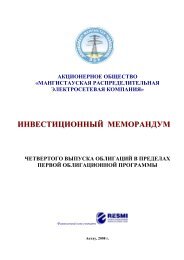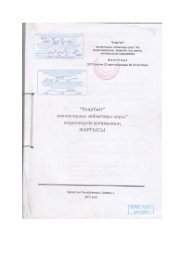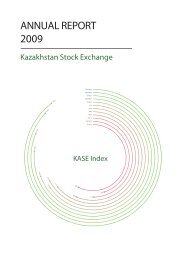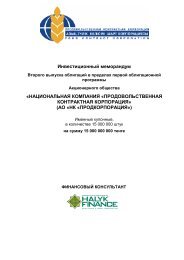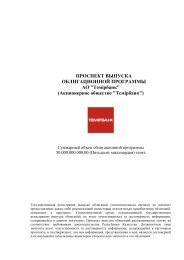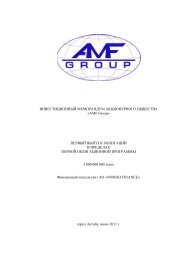JPMorgan - KASE
JPMorgan - KASE
JPMorgan - KASE
You also want an ePaper? Increase the reach of your titles
YUMPU automatically turns print PDFs into web optimized ePapers that Google loves.
Principal Sectors of the Economy<br />
Historically, metallurgy (including mining and mineral processing) has been the main industrial<br />
activity in Kazakhstan, although oil and gas related industries have become an increasingly<br />
important component of the country’s industrial base. The mineral products sector, which<br />
accounts for over 30 per cent. of exports, is Kazakhstan’s largest employer. In 1999, industrial<br />
production in the fuel industry sector increased by 14.3 per cent. from 1998 levels largely as a<br />
result of increases in the price of oil and other commodities. However, in 2000, coal production<br />
increased by 28.2 per cent. and there was an increase in crude oil production of 15.9 per cent.<br />
compared to 1999. In 2001, coal production increased by 25.4 per cent. (based upon revenues<br />
derived from coal produced as compared with 2000) and oil production increased by 4.5 per cent.<br />
(based upon revenues derived from oil produced as compared with 2000). See also “ – Natural<br />
Resources”.<br />
Agriculture has traditionally been the second largest sector in the economy, both in terms of<br />
employment and contribution to GDP. However, its relative importance has diminished in recent<br />
years due to the severe disruption of trade with the former Soviet Union, the breakdown of the<br />
agricultural credit system, as well as a lack of vital components such as fuel, fertilizers and spare<br />
parts for machinery. All agricultural production is now in the private sector and, generally,<br />
producer prices reflect world market prices.<br />
Cereal grains are an important component of agricultural output and Kazakhstan is a major<br />
producer of hard wheat, with annual production normally in the 6.8 to 8.4 million ton range. In<br />
1998, 13.5 million hectares were sown with grain, of which 10.6 million hectares were sown with<br />
wheat and beans producing a total harvest in the region of 6.4 million tons. In 1999, the area<br />
sown with grain decreased by 8.1 per cent. compared to 1998. However, due to favorable<br />
weather conditions and the introduction of new farm machinery, gross production was 28.0 per<br />
cent. higher in 1999 than in 1998. In 2000, the area sown with grain increased by 6 per cent.<br />
compared to 1999 but total production in this sector decreased by 3.3 per cent. in 2000. In 2001<br />
the area sown with grain remained the same as in 2000 but total production was 15.9 million<br />
tons, 37.0 per cent. higher than in 2000.<br />
Employment and Wages<br />
In 2001, on average 6.7 million people were employed in Kazakhstan representing approximately<br />
89.6 per cent. of the eligible workforce. Of the eligible workforce, approximately 22.7 per cent.<br />
were employed in the public sector, and approximately 66.9 per cent. of the eligible workforce<br />
were employed in the private sector.<br />
Officially registered unemployment was close to zero in the 1980s. At the end of 2001, the<br />
officially registered unemployment figure was 780,000 or 10.4 per cent. of those eligible to work.<br />
Average wages vary significantly from sector to sector. In 2001, the financial sector had the<br />
highest average wage (more than twice the national average) while wages were lowest in the<br />
agricultural sector, nearly three times less than the national average. Wages in industry currently<br />
average 37.0 per cent. higher than the national average. In 2001, the average monthly wage was<br />
17,364 Tenge, an increase of 10.4 per cent. In real terms and 26.0 per cent. in nominal terms<br />
compared with 2000.<br />
Social Security System<br />
In the years following independence, pension arrears gradually accumulated. However, by the<br />
end of 1997, the Government had cleared outstanding State pension arrears amounting to 36<br />
billion Tenge. The funding to clear these arrears came partially from reduced Government<br />
expenditures (10.7 billion Tenge) and an increase in the 1997 budget deficit from the originally<br />
budgeted 3.16 per cent. of GDP to 3.66 per cent. of GDP. All arrears in pensions were paid at the<br />
end of 1999 and the State is now current in payments.<br />
B-9




